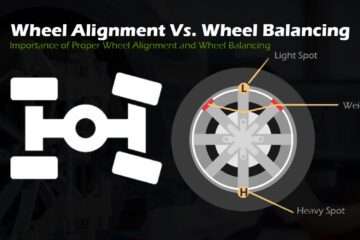When to replace car tires, Knowing when to replace your car tires is a critical part of vehicle maintenance, directly affecting your safety while driving. Tires are instrumental in providing traction, handling, and braking capabilities, underscoring the importance of identifying the optimal time for replacement. While numerous factors contribute to tire wear and durability, several key signs serve as indicators for determining when to replace car tires. These indicators encompass aspects such as tread depth, visible signs of wear, tire age, and performance changes, all of which play a crucial role in ensuring your tires continue to perform effectively and maintain road safety standards.

Tread Depth
One of the most common ways to assess tire wear and to know when to replace car tires is by checking the tread depth. Tread depth refers to the depth of the grooves in the tire’s rubber surface.
As tires wear out over time, their tread depth gradually decreases, impacting their ability to maintain optimal traction on the road. This reduction in tread depth becomes particularly concerning during wet or slippery conditions, as tires with shallow treads may struggle to effectively grip the road surface.
This can result in reduced handling capabilities, longer braking distances, and an increased risk of hydroplaning. Monitoring tread depth regularly and replacing tires before the tread depth becomes too shallow is essential for ensuring safe driving performance in various weather conditions. Most tires have built-in tread wear indicators, small bars that appear across the tread when it’s time for replacement. However, you can also use a tread depth gauge to measure the depth yourself to know when to replace car tires.
The minimum legal tread depth varies by region, but it’s generally around 2/32 of an inch. Once your tire’s tread depth reaches this level, it’s time to consider replacing them and that is the best time when to replace car tires, even if the wear appears evenly distributed.
Age of the Tires

When to replace car tires?, Tires age even if they’re not used frequently. The gradual deterioration of rubber over time can be attributed to various environmental factors such as exposure to sunlight, fluctuations in temperature, and other environmental conditions. These factors contribute to the breakdown of rubber compounds used in tires, resulting in a decrease in performance and an increase in safety risks.
Sunlight exposure can cause rubber to become brittle, while temperature fluctuations can lead to expansion and contraction, ultimately weakening the tire structure. Additionally, environmental factors like moisture, chemicals, and pollutants can further accelerate rubber degradation, highlighting the importance of proper tire maintenance and timely replacement to ensure optimal performance and safety on the road. When to replace car tires most manufacturers recommend replacing tires every 6 to 10 years, regardless of tread wear, to ensure optimal performance and safety.
When to replace car tires, You can check the age of your tires by examining the sidewall to know when to replace car tires. When inspecting your tires, search for a four-digit code imprinted into the rubber, typically found after the letters “DOT.” This code serves as a production date identifier. The first two digits reveal the week of manufacture, while the final two digits signify the year. This information is crucial for determining the tire’s age and assessing its overall condition, helping you make informed decisions regarding tire maintenance, replacement, and road safety. For example, “2419” would mean the tire was manufactured in the 24th week of 2019.
Signs of Wear and Damage
In addition to monitoring tread depth and considering the age of your tires, conducting regular inspections for signs of wear and damage is paramount. This includes checking for uneven wear patterns, cuts, punctures, bulges, cracks, and other visible indications of tire deterioration. By actively assessing these factors, you can identify potential issues early on and take proactive measures to address them, such as rotating tires, repairing punctures, or replacing damaged tires. Regular tire inspections play a vital role in ensuring optimal tire performance, vehicle safety, and peace of mind on the road. This includes:
- Uneven Wear: When observing uneven wear patterns on your tires, such as one side wearing faster than the other or a center wear pattern, it may signal underlying issues such as misalignment or improper inflation. Misalignment can cause tires to wear unevenly due to the unequal distribution of weight and forces on the tire surface. Similarly, improper inflation, either overinflation or underinflation, can lead to uneven wear, with overinflation causing center wear and underinflation causing outer edge wear. Addressing these issues promptly through wheel alignment adjustments and maintaining proper tire pressure levels is crucial to prevent further wear and ensure optimal tire performance and longevity. That let you know when to replace car tires.
- Cracks or Bulges: Check for cracks, cuts, or bulges in the tire sidewalls. These can weaken your tire’s structure and certainly increase the risk of a blowout.
- Vibration or Noise: Excessive vibration or noise while driving can indicate tire wear or alignment problems.
The Lincoln Penny Test: A Simple Way to Check Your Tire Tread Depth

The Lincoln Penny Test offers a simple and efficient way to gauge the tread depth of your car tires, helping you determine if they are still safe for driving or if it’s time for replacement. Named after the recognizable profile of Abraham Lincoln on the US one-cent coin, this test provides a straightforward method to assess tire wear and make informed decisions about tire maintenance and replacement to be able to know when to replace car tires?!.
You May Also Check
Focused on Tire Pressure Monitoring Systems (TPMS)
Introduction: Tire Pressure Monitoring Systems (TPMS) have evolved into essential safety components in contemporary vehicles. These systems play a critical […]
How to Perform the Test
- Select a Tread Groove: Choose a location on the vehicle’s tire where the tread depth seems lowest or where you suspect that the vehicle’s tire may be most worn.
- Insert the Penny: Hold the penny with Lincoln’s head facing down and insert it into the tread groove. Make sure that Lincoln’s head is entering the groove upside down and with his head pointing toward the vehicle’s tire.
- Observe the Tread Depth: Inspect how much of Lincoln’s head remains visible above the tire’s tread. If you can see the complete top of Lincoln’s head, indicating that his entire head is visible, this signals that your tire’s tread depth is insufficient. In such cases, it’s crucial to know when to replace car tires and to replace the tire to maintain safe driving conditions and ensure optimal traction and performance on the road.
What the Results Mean
- If Lincoln’s head is fully visible: when using the Lincoln Penny Test, it signifies that your tire tread has worn down to or below 2/32 of an inch. This measurement is often considered the minimum legal tread depth requirement in many regions.
- If Part of Lincoln’s Head is Covered: If part of Lincoln’s head is covered by the tread, your tire likely has sufficient tread depth remaining for safe driving. However, it’s still essential to know when to replace car tires and monitor your tire wear regularly and consider replacement once the tread wears down further.
The Washington Quarter Test: Another Method for Checking Tire Tread Depth

The Washington Quarter Test is another handy technique for evaluating your tire tread depth and determining if it’s time when to replace car tires. Similar to the Lincoln Penny Test, this method utilizes a coin—specifically, a Washington quarter—to gauge the depth of your tire treads.
How to Perform the Test
- Choose a Tread Groove: Select a spot on your tire where the tread appears worn or where you suspect the tread depth may be lower.
- Insert the Quarter: To perform the Quarter Test, take a quarter with George Washington’s head facing down and insert it into the tire’s tread groove. Ensure that Washington’s head is entering the groove upside down, with his head pointing towards the tire. This positioning allows you to gauge the depth of the tread by observing how much of Washington’s head remains visible within the groove.
- Observe the Tread Depth: Examine the portion of George Washington’s head that is still visible above the tread. If you can observe the entirety of Washington’s head, indicating that his entire head is visible, it indicates that your tire’s tread depth is inadequate. This observation suggests that it’s time to start considering when to replace car tires by replacing the tire to ensure safe driving conditions and optimal traction on the road.
Interpretation of Results
- Full Visibility of Washington’s Head: This indicates that your tire tread is worn down to or below the minimum legal tread depth, which is typically around 2/32 of an inch in many regions. Tires that have tread depth below the legal limit of 2/32 of an inch may fail to deliver sufficient traction and grip, particularly in wet or slippery road conditions. This diminished traction increases the likelihood of accidents and compromises overall driving safety.
- Partial Coverage of Washington’s Head: If part of George Washington’s head remains covered by the tire tread when performing the Quarter Test, it suggests that your tire still has sufficient tread depth for safe driving. However, it’s crucial to regularly monitor your tire wear and tread depth. As the tread continues to wear down, you should considering when to replace car tires by replacing the tire to maintain optimal traction, handling, and overall driving safety.
You May Also Check
Fullway HP108 All-Season Passenger Car Performance Radial Tire Clear Reviews
The Fullway HP108 All-Season Passenger Car performance radial tires have garnered widespread acclaim from users who are not only impressed […]
Benefits of the Washington Quarter Test
Using the Washington Quarter Test offers several advantages:
- Readily Available Coin: The Washington quarter, being a widely circulated coin, is readily available to most drivers, making the Quarter Test easily accessible and practical for checking tire tread depth.
- Simple Procedure: The Quarter Test is a simple and accessible method that does not require any specialized tools or advanced technical knowledge to perform.
- Quick Assessment: Within moments, you can determine whether your tires meet the minimum tread depth requirements for safe driving.
Environmental Factors
Environmental factors can also influence the lifespan of your tires. If you live in an area with extreme temperatures, frequent temperature fluctuations, or rough road conditions, your tires may wear out faster so you must know when to replace car tires. Additionally, driving habits, such as aggressive acceleration, braking, or cornering, can accelerate tire wear.
Conclusion (when to replace car tires?)
In conclusion, the best time to replace your car tires depends on several factors, including tread depth, age, signs of wear and damage, and environmental conditions. Regular inspections and maintenance can help you identify when it’s time for new tires, ensuring your safety and optimal vehicle performance on the road. If you’re unsure about the condition of your tires, consult a professional mechanic or tire specialist for guidance. You always must know when to replace car tires?!





always good to know when to replace those tires safety first